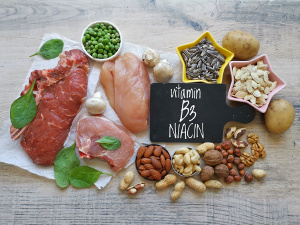Ubiquinone or Ubiquinol - does it really matter?
 Ever since the discovery of coenzyme Q10 in 1957, scientists have been conducting research with this intriguing nutrient that appears to play a crucial role in human health. Another word for coenzyme Q10 is “ubiquinone” because of its omnipotent importance. “Ubi” means everywhere. In 2006, a new type of CoQ10 called “ubiquinol” surfaced commercially. Clever marketing campaigns attempted to pawn this off as the new and improved CoQ10 source that was absorbed more easily in the body and was superior to ubiquinone. Consumers as well as scientists got confused and started questioning the traditional form of CoQ10 – ubiquinone – although it had been sold commercially and used in studies all along.
Ever since the discovery of coenzyme Q10 in 1957, scientists have been conducting research with this intriguing nutrient that appears to play a crucial role in human health. Another word for coenzyme Q10 is “ubiquinone” because of its omnipotent importance. “Ubi” means everywhere. In 2006, a new type of CoQ10 called “ubiquinol” surfaced commercially. Clever marketing campaigns attempted to pawn this off as the new and improved CoQ10 source that was absorbed more easily in the body and was superior to ubiquinone. Consumers as well as scientists got confused and started questioning the traditional form of CoQ10 – ubiquinone – although it had been sold commercially and used in studies all along.
More expensive and less stable
Is there really a difference? Is ubiquinol better than ubiquinone? Little information is available about this and to be honest, nobody really knows. In fact, the only known differences between these two types of CoQ10, besides their color (ubiquinol is milky white and ubiquinone is yellowish) is that ubiquinol is a more expensive raw material and is less stable, biochemically speaking.
Makes no difference
Because ubiquinol costs more to manufacture it is more expensive for consumers to purchase and for scientists to use in research. Ironically, CoQ10 shifts between its ubiquinone and ubiquinol form in a continuous cycle inside the body. This is all part of CoQ10’s role in biology. So when you take ubiquinol it shifts to ubiquinone and vice versa. It makes no difference in what form you take the substance.
- Ubiquinone (oxidized form) is essential for CoQ10’s role in cellular energy metabolism (ATP synthesis)
- Ubiquinol (reduced form) is essential for the antioxidant function of CoQ10
Here are some basic facts to put things into perspective:
Ubiquinone has been used in the majority of studies
- Thousands of clinical trials have been conducted with CoQ10. Only few are conducted with ubiquinol. The lion’s share of research is carried out with ubiquinone.
- The most recent groundbreaking study of CoQ10 showed a 43% lower risk for heart-related mortality among heart failure patients who took supplements of CoQ10. In this study (Q-Symbio) ubiquinone was used.
- Another study (KiSel-10) which was published a nearly two years ago and showed a 54% lower mortality rate among elderly people who took supplements of CoQ10 (and selenium) was also conducted with ubiquinone.
- Ubiquinone is available in pharmagrade material.
Ubiquinol is susceptible to oxidation
- Because ubiquinol is reduced, it is susceptible to oxidation. When it oxidizes it converts back into ubiquinone. Maintaining ubiquinol in its non-oxidized form inside the capsule created problems, as it is technically challenging to protect the vulnerable compound against oxidation.
- Ubiquinol has a milky white appearance, whereas ubiquinone is yellowish. The best way to test if the content in a ubiquinol capsule is really what it claims to be is to pierce the capsule and squeeze out the content. If it is yellowish, there is a risk that it has oxidized and turned into ubiquinone. In that case, you have not received what you paid for.
- Ubiquinol is just available in food grade material.
The absorption of ubiquinol and ubiquinone is the same
- CoQ10, regardless of its form, is absorbed through the intestinal membrane. Once it is inside the body, it shifts back and forth between the two forms.
- CoQ10 is not all that bio-available, as it is crystalline. The body cannot absorb crystals, so the CoQ10 needs to be broken down to molecules that are able to pass through the intestinal wall.
- Only few CoQ10 manufacturers have managed to develop a formula that ensures optimal absorption of the active ingredient. The CoQ10 that has the best documentation for its bio-availability features CoQ10 as ubiquinone. This specific preparation was specifically selected for the Q-Symbio and KiSel-10 studies because of its documented and reliable bio-availability, quality, and safety.
 The massive marketing campaigns for ubiquinol have left many people in the dark about what form of the substance to trust. This is clearly pointed out in a newsletter (“Coenzyme Q10 Facts or Fabrications”) that was issued by a group of leading experts. In their newsletter they call these campaigns “false” and “misleading” and say that they have only generated more confusion about CoQ10. Interestingly, they also make a point of mentioning that since the different forms of CoQ10 can easily be converted from one form to the other, it makes sense to stick with a form that is more affordable. Ubiquinone is less expensive to manufacture. Another thing that may be worth mentioning is that ubiquinol is more unstable and tends to convert back into ubiquinone in the capsule.
The massive marketing campaigns for ubiquinol have left many people in the dark about what form of the substance to trust. This is clearly pointed out in a newsletter (“Coenzyme Q10 Facts or Fabrications”) that was issued by a group of leading experts. In their newsletter they call these campaigns “false” and “misleading” and say that they have only generated more confusion about CoQ10. Interestingly, they also make a point of mentioning that since the different forms of CoQ10 can easily be converted from one form to the other, it makes sense to stick with a form that is more affordable. Ubiquinone is less expensive to manufacture. Another thing that may be worth mentioning is that ubiquinol is more unstable and tends to convert back into ubiquinone in the capsule.
Summary
- The amount of scientific studies conducted with ubiquinone Q10 is far more extensive than the number of studies carried out with ubiquinol
- In terms of absorption, there is no difference between ubiquinone and ubiquinone
- Ubiquinone and ubiquinol shift from one form to the other inside the body. What matters is to ensure proper absorption.
- ICQA uses a ubiquinone formula as its official science reference
- Ubiquinol cost more to manufacture than ubiquinone and is therefore more expensive for consumers and researchers
- Created on .











 "After about one week of taking the Q10 supplement I could feel a huge difference," says 23-year old Alan Piccini, who has been suffering from extreme fatigue and muscle aches ever since he was a child.
"After about one week of taking the Q10 supplement I could feel a huge difference," says 23-year old Alan Piccini, who has been suffering from extreme fatigue and muscle aches ever since he was a child. “Taking capsules with co-enzyme Q10 has freed me of the severe side effects of my cholesterol lowering medicine,” Mrs Franken explains.
“Taking capsules with co-enzyme Q10 has freed me of the severe side effects of my cholesterol lowering medicine,” Mrs Franken explains.